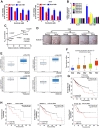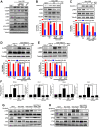Galectin-1-mediated MET/AXL signaling enhances sorafenib resistance in hepatocellular carcinoma by escaping ferroptosis
- PMID: 37433225
- PMCID: PMC10373977
- DOI: 10.18632/aging.204867
Galectin-1-mediated MET/AXL signaling enhances sorafenib resistance in hepatocellular carcinoma by escaping ferroptosis
Abstract
Sorafenib, a small-molecule inhibitor targeting several tyrosine kinase pathways, is the standard treatment for advanced hepatocellular carcinoma (HCC). However, not all patients with HCC respond well to sorafenib, and 30% of patients develop resistance to sorafenib after short-term treatment. Galectin-1 modulates cell-cell and cell-matrix interactions and plays a crucial role in HCC progression. However, whether Galectin-1 regulates receptor tyrosine kinases by sensitizing HCC to sorafenib remains unclear. Herein, we established a sorafenib-resistant HCC cell line (Huh-7/SR) and determined that Galectin-1 expression was significantly higher in Huh-7/SR cells than in parent cells. Galectin-1 knockdown reduced sorafenib resistance in Huh-7/SR cells, whereas Galectin-1 overexpression in Huh-7 cells increased sorafenib resistance. Galectin-1 regulated ferroptosis by inhibiting excessive lipid peroxidation, protecting sorafenib-resistant HCC cells from sorafenib-mediated ferroptosis. Galectin-1 expression was positively correlated with poor prognostic outcomes for HCC patients. Galectin-1 overexpression promoted the phosphorylation of AXL receptor tyrosine kinase (AXL) and MET proto-oncogene, receptor tyrosine kinase (MET) signaling, which increased sorafenib resistance. MET and AXL were highly expressed in patients with HCC, and AXL expression was positively correlated with Galectin-1 expression. These findings indicate that Galectin-1 regulates sorafenib resistance in HCC cells through AXL and MET signaling. Consequently, Galectin-1 is a promising therapeutic target for reducing sorafenib resistance and sorafenib-mediated ferroptosis in patients with HCC.
Keywords: Galectin-1; ferroptosis; hepatocellular carcinoma; sorafenib resistance.
Conflict of interest statement
Figures






References
-
- Llovet JM, Ricci S, Mazzaferro V, Hilgard P, Gane E, Blanc JF, de Oliveira AC, Santoro A, Raoul JL, Forner A, Schwartz M, Porta C, Zeuzem S, et al., and SHARP Investigators Study Group. Sorafenib in advanced hepatocellular carcinoma. N Engl J Med. 2008; 359:378–90. 10.1056/NEJMoa0708857 - DOI - PubMed
Publication types
MeSH terms
Substances
LinkOut - more resources
Full Text Sources
Medical
Research Materials
Miscellaneous

